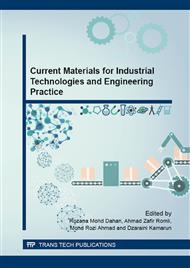p.138
p.143
p.147
p.154
p.160
p.165
p.171
p.178
p.185
Thermal Conductivity of Paraffin Wax as Microencapsulated Phase Change Material (PCM) Coated on Polyester Fabric
Abstract:
This research works involves the production of microencapsulated phase change material (PCM) in which paraffin wax was used as the core components with sebacyol chloride (SC) and hexamathylene diamine (HMD) as the shell component. The microencapsulated PCM was characterized using Fourier Transform Infrared (FTIR) and scanning electron microscopy (SEM). Thermal energy storage capacity was measured by differential scanning calorimetry (DSC) while thermal conductivity was measured by thermal gravimetric analysis (TGA). The microencapsulated PCM were found to have a regular spherical shape with a size of 50µm while FTIR indicated that the microencapsulation process occurs due to the existence of alkyl group (C-H) and carbonyl group (C=O) in the spectra. DSC analysis shows that the paraffin start to melt at 47°C to 56°C with thermal energy storage capacity of 140.097 J/g and 114.766 J/g for sample A and sample B respectively. It was found that higher value of thermal energy storage resulting to lower thermal conductivity, which can be used as a thermal barrier in various applications.
Info:
Periodical:
Pages:
160-164
Citation:
Online since:
December 2015
Price:
Сopyright:
© 2016 Trans Tech Publications Ltd. All Rights Reserved
Share:
Citation:


